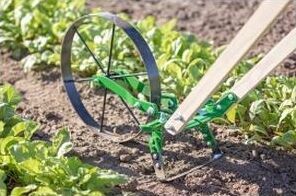Wheel Hoes - Purchasing, FAQ, and more
Click here to jump down to the FAQ section
● Cultivator Teeth
● Weeding Hoes
...and more! Kiss hours of back breaking labor goodbye. These Wheel Hoes will cut your project time in half.
How To Select The Right Wheel Hoe
We have 3 different types of wheel hoes to choose from:
the
It is best to choose based on both 1) the size of your garden, and 2) the tasks you want to use it for.
1) The size of your garden...
- For small and medium gardens, choose the Euro or the Hoss wheel hoe.
- For medium and large gardens, choose the Hoss or the High-Arch wheel hoe.
2) The tasks you want to do...
- For cultivating, weeding, and furrowing: All three models can do these.
- For hilling and ridging with the Plows, use the Hoss or High-Arch model.
- For using the Disc Harrow attachment, only the Hoss model will work.
- For straddle weeding small crops, use the Hoss double-wheel or the High Arch.
- For straddle weeding tall crops, only the High Arch model will work.
All with Free Shipping PLUS a One Year Warranty...
EURO Wheel Hoe
This European wheel hoe comes with everything you need. Steel construction with handles that can be pivoted up and down, or left and right. Includes three popular attachments that can be easily exchanged with no tools. Additional 12" hoe available here
EURO
Complete with all 3 attachments = $199
Choose model ▶
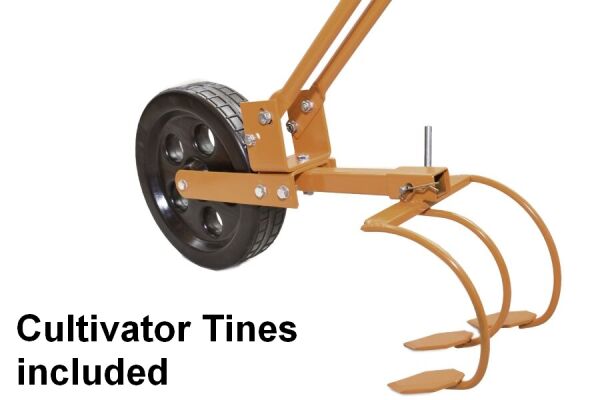
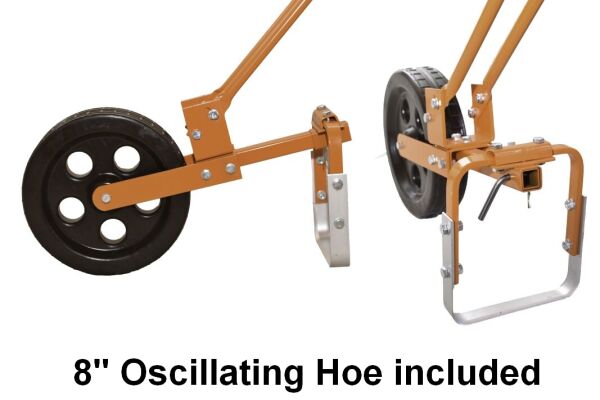
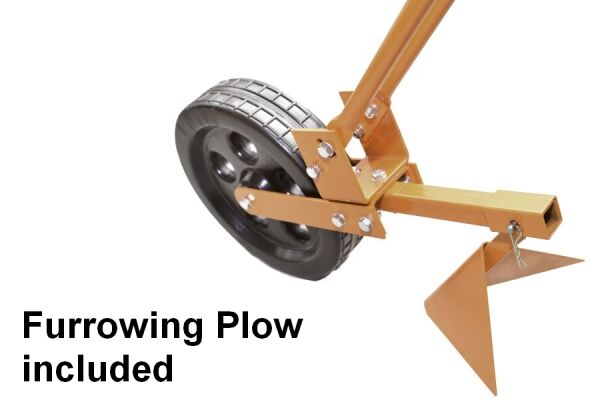
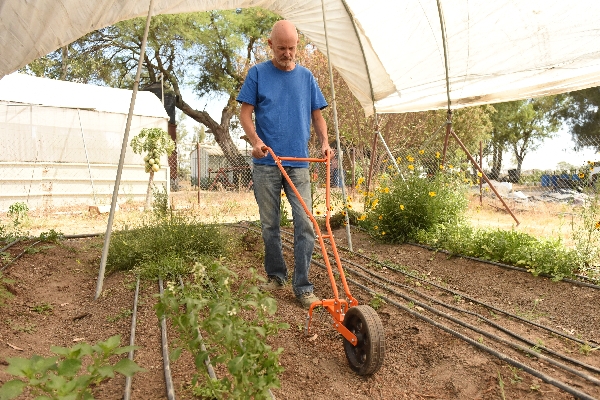
Includes: Single Wheel unit, 8" Oscillating Hoe, Furrowing Plow, and Cultivator Tines. More Info...
HOSS Wheel Hoe (single or double)
The original Hoss model is the most popular wheel hoe!
It has more useful attachments than any other brand of wheel hoe.
The Single Wheel model is easy to steer, and the Double Wheel version increases your weeding options.
Single Wheel model = $249
Double Wheel model = $289
Choose model ▶
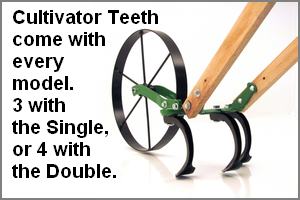
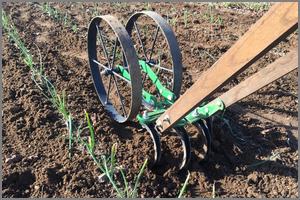
Includes: Single or Double Wheel unit, and Cultivator Teeth. More Info...
Single Wheel model =
$352 $339
Double Wheel model =
$392 $379
Choose model ▶



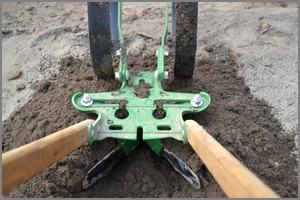
Includes: Single or Double Wheel unit, Plow Set, 8" Oscillating Hoe, and Cultivator Teeth. More Info...
HIGH ARCH Wheel Hoe
The Hoss High Arch model excels at weeding, cultivating, or plowing BOTH sides of a row of crops at the same time. This technique is called "straddling" and it literally cuts your work in half.
● Straddle cultivating with the teeth loosens the soil on both sides at once.
● Straddle weeding slices weeds left and right with the same amount of effort.
● Straddle plowing (hilling) moves soil up & over the base of plants like corn & potatoes.
● Click to see all the Hoss Attachments
Base model with cultivator teeth = $379
Choose model ▶ In Stock
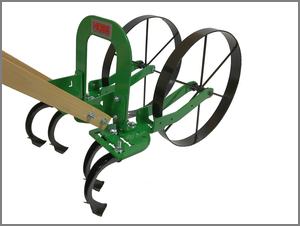

Includes: Double Wheel High-Arch unit and 4 Cultivator Teeth. More Info...
LOADED High-Arch
Base model + accessories =
$516 $499



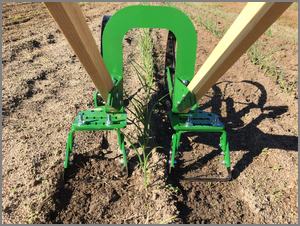
Includes: Double Wheel High-Arch unit, Plow Set, two of 6" Oscillating Hoes, and 4 Cultivator Teeth. More Info...
Frequently Asked Questions (FAQ) about wheel hoes
Or see the index of all our
What is a wheel hoe used for, and how to use it?
- Wheel hoes are garden tools pushed through rows to weed, till, cultivate or plow. They feature a wheel in the front, a tool-mounting area in the middle, and handles in the rear.
- When using a wheel hoe, first choose the right attachment for the job and then adjust the handles to your hip height.
- Keep your hands level while pushing the wheel hoe. Try to walk steadily forward, using you leg muscles rather than your arm and shoulder muscles.
- Click to see the full article
What are the advantages of using a wheel hoe?
- Wheel hoes provide increased productivity, less strain on the user's body, and more accurate results compared to other tools like tillers of garden hoes.
- The wheel hoe is easier to maneuver and control than a rototiller. It is peaceful and has no engine that needs maintenance. They also last longer than a tiller.
- It takes much less time and effort to cultivate and weed with a wheel hoe compared to using a garden hoe.
- Click to see the full article
What is the difference between a Single and a Double Wheel Hoe?
- Single wheel hoe allows more precise steering, is easier to maneuver in tight spaces, and is lighter.
- Double wheel hoe is able to straddle weed crops, and will easily stand on its own when you let go of the handles.
- Factors to consider when choosing between single and double wheel hoes include: type of crops, your desire to straddle weed or straddle cultivate, the size of garden, cost, and maneuverability.
- Click to see the full article
Which brand of wheel hoe should I buy?
- There are five modern wheel hoe brands (Glaser, Hoss, Valley Oak, Euro, and Terrateck) available in the USA. Each comes with different features and widely varied prices.
- Attachments can vary depending on the brand. The more attachments available for a brand can make it more useful.
- Modern low-wheel hoes differ from older high-wheel cultivators by wheel diameter. High-wheel units have 24" or larger wheels, while low-wheel units have 10" to 16" wheels. All modern brands are low-wheel, except the Earthway.
- Click to see the full article
What Attachments are available for different wheel hoes?
- Attachments available include those for cultivating, weeding, plowing, and specialty tasks.
- Cultivating attachments loosen and aerate the upper layer of soil. They are also great for large weed removal.
- Weeding attachments cut or drag the weed shallowly through the top layer of soil, leaving the soil's layer structure intact.
- Plowing attachments move soil by digging down and pushing or rolling the dirt upwards and to the side or sides.
- Specialty attachments are useful for very specific jobs, such as laying drip tape or preparing a seed bed.
- Click to see the full article
- See all the Hoss Attachments that we sell.
Why is a wheel hoe also called a Wheel Cultivator?
- Cultivating is the process of loosening the top layer of soil, improving air circulation, water absorption and nutrient availability. It uses tines or teeth that are pushed through the soil to stir it.
- A wheel hoe fitted with cultivator tines or teeth makes cultivating much easier and faster than manual alternatives like garden hoes or rakes.
- You can use a wheel cultivator to break up soil crust, do shallow soil aeration, rip up large weeds, or prepare an area for seeding.
- Click to see the full article
What does a wheel hoe Hiller do?
- A wheel hoe hiller is used for fast efficient hilling. Hilling is the process of pulling up path soil and piling it all along a row of crop plants to bury and smother small weeds that have sprouted between the crop plants.
- Hilling can be done weekly during the growing season. Hoe or pull any large weeds that appear through the hilled ridge.
- Hilling one side of row at a time can be done with a single-wheel hoe and a single plow. Straddle hilling (piling soil on both sides of the row at once) requires a double-wheel hoe and a pair of plows.
- Click to see the full article
What does it mean to backcut while using a wheel hoe?
- Backcutting is done with a weeding attachment called an Oscillating Hoe fastened to a wheel hoe. This double-sided blade has a pivot mechanism to let it cut or scrape weeds in both directions.
- An oscillating hoe is mostly used by pushing forward with the blade cutting 1/2 inch into the surface (forward cutting). It is used for small to medium weeds that are not densely grouped.
- Back cutting involves pulling the wheel hoe backwards over a tough weed or dense weedy spot while lowering the handles to lifting the front wheel off the ground. This puts the entire weight of the wheel hoe onto the Oscillating Hoe blade so it can cut and scrape aggressively.
- Click to see the full article
How does a wheel hoe compare to a rototiller?
- Our comparison between a wheel hoe and rototiller was made on a large (1.5 acre) garden with heavy clay-loam soil. The tiller had drawbacks such as disrupting soil integrity, forming a hardpan layer below the surface, requiring fuel and maintenance, and danger from it's moving parts.
- Wheel hoes are better for light cultivation and weed control of small weeds. Tillers work better for breaking up sod, turning under compost, and for killing off large weed masses.
- Wheel hoes are less expensive, quieter, less polluting, and more maneuverable than tillers. Other differences include user safety and maintenance costs.
- Click to see the full article
What is the History of the wheel hoe
- In 1890, SL Allen and Company began selling various Planet Jr models. These were lightweight, multipurpose machines that farmers pushed. They specialized in push wheel hoes and automatic seed drills that allowed four-fold efficiency increases over crop management with garden hoes.
- Home gardeners soon realized that vegetable gardens could be redesigned to make the most of wheel hoe efficiency, which generated a larger system of gardening.
- In the 1930's, Planet Jr introduced the Two-wheel garden tractor, which eliminated the need for horse-powered implements.
- By the 1940's even the previously dismissive government-backed researchers were acknowledging that manual wheel hoes made sense in any small-farm financial equation.
- Click to see the full article
Is a wheel hoe worth it?
- Compared to a garden hoe, using a wheel hoe can save time (two to ten times faster) and reduce muscle effort when weeding or hilling.
- Compared to a rototiller, using a wheel hoe requires less investment, energy, and maintenance - yet still provides efficient cultivation of soil, and the added ability to weed, furrow, and hill.
- The prices for a wheel hoe with attachments can range from $200 to $700 depending on brand, model, and attachments.
- Click to see the full article
- Read Customer's Reviews of all our wheel hoes.
What is special about the Loaded packages?
Years ago, we noticed lots of people buying plows and oscillating hoes with their basic wheel cultivators.
So we made packages out of them to make your decision easier, and save you some money.
Both of the Loaded packages do save some money over buying the same components separately.
If you want to add even more wheel hoe attachments, you can find them all listed on the
Attachments page.
For a comparison of other brands, see the Wheel Hoe Buying Guide


